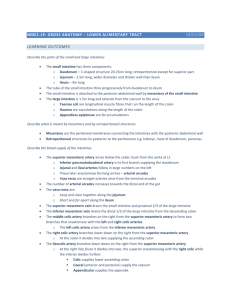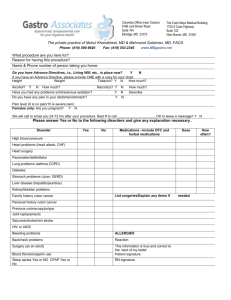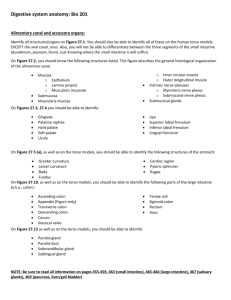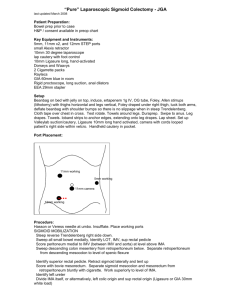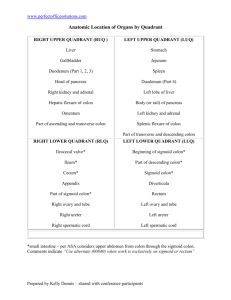Dissection 25
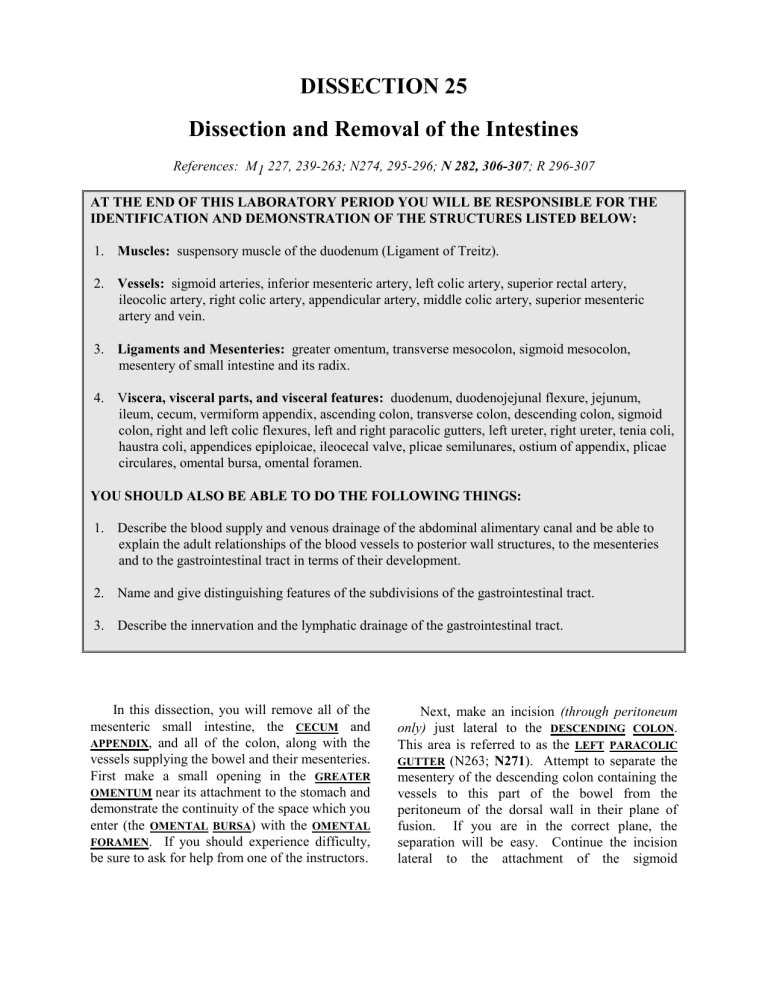
DISSECTION 25
Dissection and Removal of the Intestines
References: M1 227, 239-263; N274, 295-296; N 282, 306-307 ; R 296-307
AT THE END OF THIS LABORATORY PERIOD YOU WILL BE RESPONSIBLE FOR THE
IDENTIFICATION AND DEMONSTRATION OF THE STRUCTURES LISTED BELOW:
1. Muscles: suspensory muscle of the duodenum (Ligament of Treitz).
2. Vessels: sigmoid arteries, inferior mesenteric artery, left colic artery, superior rectal artery, ileocolic artery, right colic artery, appendicular artery, middle colic artery, superior mesenteric artery and vein.
3. Ligaments and Mesenteries: greater omentum, transverse mesocolon, sigmoid mesocolon, mesentery of small intestine and its radix.
4. V iscera, visceral parts, and visceral features: duodenum, duodenojejunal flexure, jejunum, ileum, cecum, vermiform appendix, ascending colon, transverse colon, descending colon, sigmoid colon, right and left colic flexures, left and right paracolic gutters, left ureter, right ureter, tenia coli, haustra coli, appendices epiploicae, ileocecal valve, plicae semilunares, ostium of appendix, plicae circulares, omental bursa, omental foramen.
YOU SHOULD ALSO BE ABLE TO DO THE FOLLOWING THINGS:
1. Describe the blood supply and venous drainage of the abdominal alimentary canal and be able to explain the adult relationships of the blood vessels to posterior wall structures, to the mesenteries and to the gastrointestinal tract in terms of their development.
2. Name and give distinguishing features of the subdivisions of the gastrointestinal tract.
3. Describe the innervation and the lymphatic drainage of the gastrointestinal tract.
In this dissection, you will remove all of the mesenteric small intestine, the CECUM and
APPENDIX , and all of the colon, along with the vessels supplying the bowel and their mesenteries.
First make a small opening in the GREATER
OMENTUM near its attachment to the stomach and demonstrate the continuity of the space which you enter (the OMENTAL BURSA ) with the OMENTAL
FORAMEN . If you should experience difficulty, be sure to ask for help from one of the instructors.
Next, make an incision (through peritoneum only) just lateral to the DESCENDING COLON .
This area is referred to as the LEFT PARACOLIC
GUTTER
(N263; N271 ). Attempt to separate the mesentery of the descending colon containing the vessels to this part of the bowel from the peritoneum of the dorsal wall in their plane of fusion. If you are in the correct plane, the separation will be easy. Continue the incision lateral to the attachment of the sigmoid
Dissection 25, Removal of the Intestines Page 2 mesocolon and remove the peritoneum from the left side of the SIGMOID MESOCOLON . Identify the SIGMOID ARTERIES (G2.40, 48; N296; N307 ) supplying the
SIGMOID COLON and clean them back to the INFERIOR MESENTERIC ARTERY .
Then find the LEFT COLIC ARTERY , which supplies the descending colon, and the SUPERIOR
RECTAL ARTERY , which is the continuation of the inferior mesenteric artery beyond the last sigmoid artery. Taking care not to include the superior rectal artery, make two ligatures with heavy string around the bowel at the rectosigmoid junction and then transect the bowel between the ties. In doing this, it will be helpful to “milk” any fecal material in the lower portions of the bowel up into the descending colon to gain access to the rectosigmoid junction. ( NOTE: Be sure to make this cut all the way to the rectosigmoid junction which is at the floor of the pelvis – otherwise you will have to do it again when you dissect the pelvis.) In the extraperitoneal connective tissue near where the attachment of the sigmoid mesocolon crosses the pelvic brim and just lateral to the superior rectal vessels, identify the LEFT URETER (G2.48; N266; N274 ).
At this time clean only enough of it to establish its relationship to the left colic artery. Then free the descending colon and sigmoid by cutting the left colic vessels and sigmoid vessels at their origin from the inferior mesenteric vessels. Leave the superior rectal vessels intact .
Now, make an incision lateral to the
ASCENDING COLON in the RIGHT PARACOLIC
GUTTER , and reflect the ascending colon and cecum medially. Again, the separation will be easy if you are in the correct plane. Identify the branches of the superior mesenteric artery to this portion of the bowel - the RIGHT COLIC ARTERY and the ILEOCOLIC ARTERY (G2.43; N296;
N307 ). Locate the RIGHT URETER and clean a short segment of it. Demonstrate its relationship to the ileocolic artery. Look for the
APPENDICULAR ARTERY .
Lift the RIGHT COLIC FLEXURE away from the surface of the right kidney and then identify the MIDDLE COLIC ARTERY and clean it back to the SUPERIOR MESENTERIC ARTERY , which, along with the SUPERIOR MESENTERIC VEIN , should be cut just proximal to the middle colic vessels.
Again, identify the DUODENOJEJUNAL
FLEXURE . By pulling downward on the jejunum at this point, attempt to demonstrate the position of the SUSPENSORY MUSCLE OF THE
DUODENUM , which holds this part of the bowel in a relatively fixed position. The suspensory muscle of the duodenum is frequently referred to as the Ligament of Treitz. Cranially, it is attached to the right crus of the diaphragm (N262; N270 ).
Examine the MESENTERY OF THE JEJUNUM
AND ILEUM . Note whether or not the fat in the mesentery reaches all the way to the margin of the bowel. Remove the peritoneum from the right side of the mesentery of about six inches of the proximal jejunum. Do the same for the terminal ileum. Clean the arteries thus revealed from the superior mesenteric to the margin of the bowel and compare the number of arcades and the length of the vasa recta in the two regions.
The JEJUNUM , ILEUM , and the colon should now be removed by placing a double ligature at the jejunal end and cutting between the ligatures.
Using blunt dissection, free the RADIX of the mesentery from the parietal peritoneum of the dorsal wall. Reflect, with their vessels, the descending colon and the ascending colon medially and separate the TRANSVERSE COLON from the greater omentum. Bluntly separate the
TRANSVERSE MESOCOLON from the dorsal wall.
You should now be able to lift out the entire intestine caudal to the DUODENUM with its mesenteries and vessels.
Features of the interior of the intestines may now be studied. DO NOT WASH OUT THE
INTESTINAL CONTENTS INTO THE
SINKS!!!
Fecal material should be placed in the tissue buckets. Place a ligature around the ascending colon about six inches above the ileocecal junction and make a vertical incision in the anterior wall of the cecum and the lower part of the ascending colon. Remove the contents and clean the mucosa with paper towels which should be placed in the tissue bucket. Identify the
ILEOCECAL VALVE and the OSTIUM of the
Dissection 25, Removal of the Intestines Page 3
APPENDIX (G2.42; N274; N282 ). Place two ligatures about eight inches apart around the transverse colon and make an incision along one of the tenia. After removing the contents identify the PLICAE SEMILUNARES (G2.40
N276; N284 ).
Note the TENIA COLI , HAUSTRA COLI , and
APPENDICES EPIPLOICAE of the colon. Make attachment of the mesentery at the proximal end of the jejunum and at the distal end of the ileum, and compare the height and number of the
PLICAE CIRCULARES in the two regions. Look for aggregated and solitary lymph follicles. If any lymph follicles are found, be sure to demonstrate them to your instructor. longitudinal cuts in the small intestine near the
______________________________________________________________________________________________
STUDY QUESTIONS
1. What are the subdivisions of the small intestine?
1. The duodenum, jejunum, and ileum.
2. Which is longer, the jejunum or the ileum?
2. The ileum. By definition it is the caudal 3/5 of the mesenteric small intestine.
3. Which of the two parts of the mesenteric small intestine has: thicker walls? greater diameter? higher and more numerous plicae circulares? aggregated lymph follicles? mesenteric fat which reaches the margin of the bowel? three or four arterial arcades in the mesentery?
"windows" in the mesenteric fat?
4. What are the subdivisions of the large intestine?
3.
The jejunum
The jejunum
The jejunum
The ileum
The ileum
The ileum
The jejunum
4. The cecum and appendix, the colon (ascending, transverse, descending, and sigmoid), and the rectum and anal canal.
5. Tenia coli, haustra coli, appendices epiploicae, plicae semilunares.
5. List the four principal gross features by which large intestine can be distinguished from small intestine.
6. How are the tenia coli related to the base of the appendix?
6. The three tenia meet at the base of the appendix.
Dissection 25, Removal of the Intestines Page 4
7. Define the cecum. 7. The cecum is that part of the large intestine caudal to the level of the entrance of the ileum.
8. Name the branches of the superior mesenteric and inferior mesenteric arteries which supply the large intestine.
8. The ileocolic, right colic, middle colic, left colic, sigmoid, and superior rectal arteries.
9. What is the marginal artery?
10. Trace blood from the sigmoid colon to the heart using the normal route.
11. Trace blood from the sigmoid colon to the heart using anastomotic connections about the rectum.
12. Locate the cell bodies of afferent fibers (for pain) to the a) stomach. b) appendix. c) transverse colon. d) descending colon. e) rectum.
13. Trace a nerve impulse from the central nervous system which results in increased secretion and motility in: a) the ascending colon b) the descending colon.
9. The marginal artery is the continuous channel formed by the series of anastomoses between the branches of the arteries listed in 8.
10. Sigmoid vein -- inferior mesenteric vein -- splenic vein -- portal vein -- sinusoids of the liver -- hepatic vein -- inferior vena cava -- right atrium.
11. Sigmoid vein -- inferior mesenteric vein -- superior rectal vein -- middle rectal vein-- internal iliac vein -- common iliac vein -- inferior vena cava -- right atrium.
12. a) dorsal root ganglion of T
6 b) dorsal root ganglion of T
8
(M
1
: T
10
) c) dorsal root ganglion of T
10 d) dorsal root ganglion of L
1 e) dorsal root ganglion of S
2
(These levels are taken from Hollingshead)
13. a) preganglionic neuron in the dorsal motor nucleus of the vagus - vagus nerve - superior mesenteric plexus - plexus on ileocolic artery – synapse on postganglionic neuron in wall of ascending colon - postganglionic fibers to glands and smooth muscle of ascending colon. b) Preganglionic neuron in sacral autonomic nucleus - ventral root S
2
- pelvic splanchnic nerve
- pelvic plexus - postganglionic neuron in wall of descending colon - postganglionic fibers to glands and smooth muscle of descending colon.
Dissection 25, Removal of the Intestines Page 5
14. Into which nodes does lymph from the following parts of the intestines drain? a) mesenteric small intestine b) appendix c) cecum and ascending colon d) transverse colon e) descending colon f) sigmoid colon.
14. See H670-672 and M1238, 246, 252-253
15. What types of nerve fibers are found in the plexus on the superior mesenteric artery? In the myenteric and submucosal plexuses? Locate their cell bodies.
16. Name several peritoneal recesses. What are their importance?
17. From what artery does the appendicular artery branch?
18. What is a Meckel's diverticulum? Where does it occur? In which part of the bowel and on which border?
LJ:bh revised 06/18/09
